The Cultural Significance in Wedding Attire: Celebrating Traditions and Modern Expressions
The Cultural Significance in Wedding Attire: Celebrating Traditions and Modern Expressions
Weddings are not merely a union of two individuals; they are profound cultural events that showcase unique traditions, values, and histories. One of the most crucial elements of a wedding is the attire, which can often carry deep cultural significance. This article delves into the various aspects of cultural significance in wedding attire, highlighting how different cultures express their identities through wedding outfits, and examining relevant trends and practices.
Understanding Cultural Significance in Wedding Attire
Wedding attire varies dramatically around the world, serving as a reflection of cultural backgrounds and personal values. Each piece of clothing selected for a wedding has profound meanings attached to it, often representing heritage, custom, and sentiment. From the rich and vibrant fabrics to intricate designs, wedding attire tells a story that resonates with the couple's culture.
Historical Perspectives on Wedding Attire
Historically, wedding attire has evolved based on societal norms and cultural practices. Even in the past, attire for marrying ceremonies communicated status, wealth, and family lineage. For example, in many Western cultures, white Wedding dresses gained popularity in the 19th century, starting with Queen Victoria's choice to wear white in her 1840 wedding to Prince Albert. This choice transformed the perception of bridal attire, symbolizing purity and innocence.
Global Variations in Wedding Attire
Unearthing the cultural significance of wedding attire means exploring various traditions around the world. Here are some notable examples:
| Region | Attire | Cultural Significance |
| India | Saree and Sherwani | Bright colors symbolize joy and prosperity. Traditional attire often includes intricate embroidery representing regional artistry. |
| China | Qipao (Cheongsam) and Dragon- and Phoenix-embroidered outfits | The color red symbolizes good fortune and joy, whereas the phoenix and dragon represent harmony and balance in marriage. |
| Middle East | Kaftan and Thobe | Attire reflects cultural identity; vivid designs and luxurious fabrics signify wealth and status. |
| Scotland | Kilt | The kilt represents heritage and clan affiliation, often adorned with family tartans and colors. |
| Africa | Traditional Attire (e.g., Kente cloth) | Colors and patterns reflect cultural identity, often associated with personal accomplishments. |
The Modern Influence on Wedding Attire
As the world continues to globalize, the influence of modern trends on traditional wedding attire becomes increasingly prevalent. Couples today often interweave cultural elements with contemporary designs, creating a unique fusion that is both personal and meaningful. This incorporation of modern styles might include:
- Choosing a non-traditional bridal dress or suit that speaks to the couple's identity.
- Incorporating accessories that showcase cultural heritage, such as heirloom jewelry or traditional textiles.
- Adopting or adapting traditional attire to fit personal aesthetic preferences without losing cultural significance.
Fashion and Cultural Identity
Wedding attire serves as a canvas through which cultural identities are expressed. It allows couples to celebrate their customs while making bold individual choices. In recent years, designers have focused on creating attire that not only reflects cultural significance but also aligns with the couple's values and personal stories.

Choosing Attire: Key Considerations
When selecting wedding attire, several factors play an essential role in ensuring that the outfit reflects both personal preferences and cultural significance:
Consultation with Family and Community
For many cultures, choosing wedding attire involves seeking input from family members or community leaders. This practice not only strengthens familial bonds but also ensures that the attire aligns with cultural expectations and designs that have been passed down through generations.
Respecting Traditions
Even when opting for modern designs, respecting the core elements of cultural attire is crucial. Maintaining traditional colors, patterns, and styles demonstrates appreciation for cultural heritage and honors the individuals who came before.
Personalization
While it is important to adhere to cultural norms, personalization can add a layer of uniqueness to attire. Custom-made outfits that incorporate themes or colors significant to the couple’s relationship can make the attire feel special while still retaining its cultural roots.
Conclusion: Embracing Cultural Significance in Wedding Attire
In conclusion, the cultural significance in wedding attire reveals a tapestry of traditions, values, and personal stories intertwined across various cultures. Couples are increasingly finding ways to harmonize traditional elements with modern expressions, creating a distinctive style that symbolizes their commitment while honoring their heritage. As globalization continues to bring different cultures together, wedding attire will likely evolve, reflecting both historical roots and individual identities. When choosing wedding attire, individuals should think about the history, symbolism, and personal relevance behind the garments they choose, making a choice that resonates with their cultural identity as well as their love story.
Ultimately, the significance of wedding attire lies not just in its appearance, but in its ability to tell a story—one that belongs to the couple, their families, and their traditions. When planning your wedding, take the time to explore the cultural importance of the attire you choose, ensuring that it celebrates the journey you are embarking on together.
